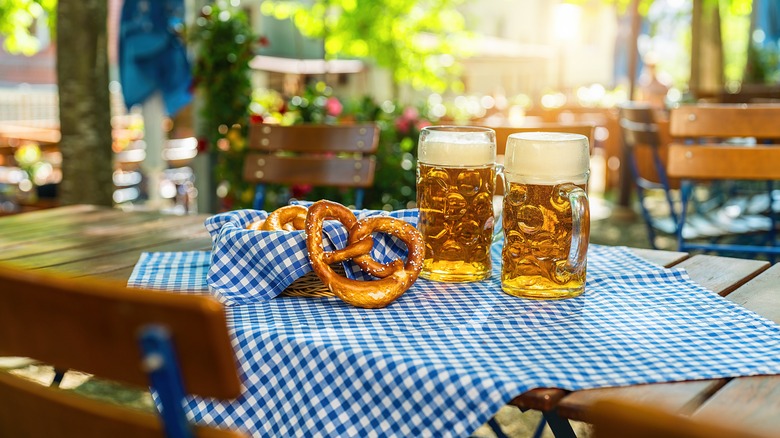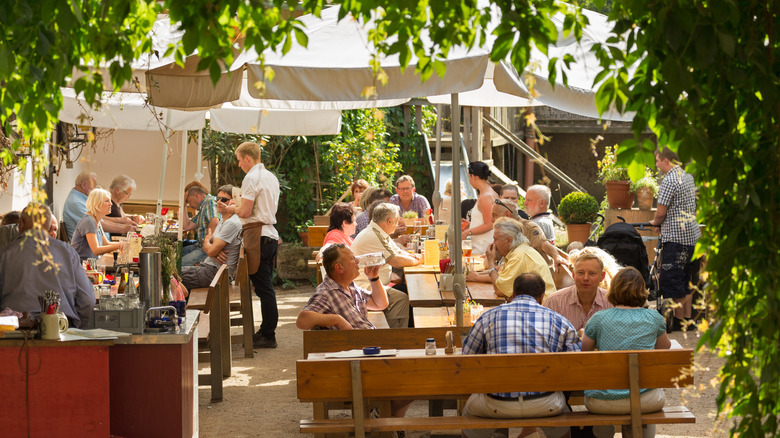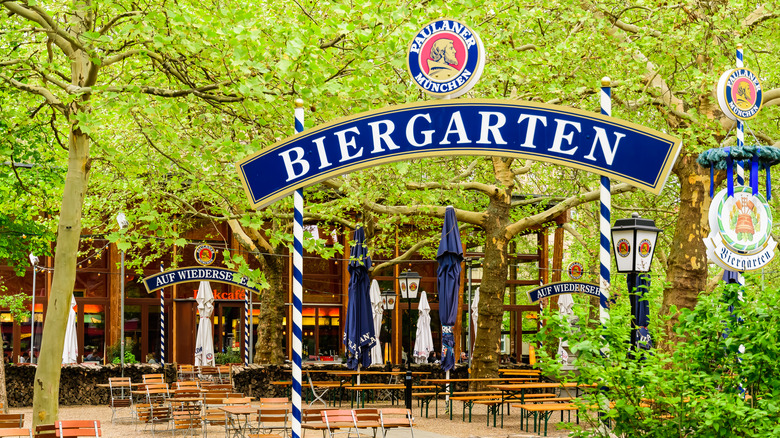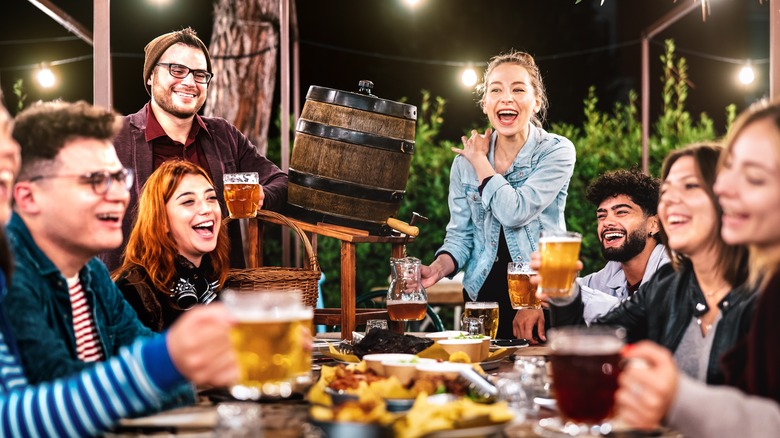The 19th Century Origins Of German Beer Gardens In The US
Whether you say "cheers" or "prost," a cold beer enjoyed on a wooden picnic table under leafy trees and a blue sky always tastes great. For generations, Europeans and Americans have enjoyed the relaxed atmosphere of outdoor German beer gardens where the beer is often sold in large glass steins and laughter is plentiful, while the lederhosen is optional. While originating in Germany, the beer garden has gained many fans across the United States and the world.
Although Germans did not invent beer, it has been an important part of the country's culture for about 1,000 years. And for the centuries following, Germans continued to be the top producers of beer in the world. Through exports and German brewers who emigrated to other countries, the world got to know the taste of pilsner, kölsch, and malt beer, among many others. And eventually, they also became familiar with the annual Oktoberfest celebration and communal enjoyment of beer in a park-like setting called a biergarten or beer garden.
A way to keep the beer cool
Like so many innovations, beer gardens were invented out of necessity. When German breweries were faced with a ban on beer brewing during the summer months due to the risk of fire in the 16th century, they opened up beer gardens on the land where their cellars were located. With trees for shade to help keep the cellars cool, it felt natural to set up tables and chairs for the consumption of the beer. The communal beer gardens proved to be a hit among area residents who found themselves not only enjoying a stein of beer at a table but also music, games, and conversation.
What visitors often couldn't enjoy, however, was food. After innkeepers and tavern owners complained about the loss of business to beer gardens, Maximilian I declared in 1812 that breweries could continue to sell beer in their gardens, but not food, except for bread. That ban was rescinded later in the century, and food is now sold at the beer gardens or biergartens. Classic fare includes pretzels, bread, sausage, German salads, and spätzle. Open from spring until the autumn, German beer gardens remain a popular gathering place and are common and found in most cities and villages, often in the main square.
Coming to America
Along with pretzels, sauerkraut, and bratwurst, 19th-century immigrants from Germany to the United States brought with them an appreciation for the social consumption of beer in a park-like setting. Beer gardens were created in areas with large German immigrant populations, like Milwaukee, Wisconsin, home to Pabst, Schlitz, and Miller breweries. However, the city's first beer gardens, like in many cities across America, were not affiliated with breweries and competed with each other for customers with special activities and performers. Eventually, the large breweries got on board. Frederick Schlitz created one of the larger beer gardens in Milwaukee in 1879. A concert hall, wild animal viewing, and a pagoda were all part of Schlitz Garden. Not only did these beer gardens around the United States serve as a place to relax and enjoy a pint of pilsner, but they also served as a community center of sorts where residents could come together and share stories, host political events, and other cultural functions.
The heyday of beer gardens in America only lasted for a few decades, with many of Milwaukee's and the nation's beer gardens closing even before Prohibition began due to anti-German sentiment at the time of World War I. It wasn't until about a century later that beer gardens began to experience a resurgence.
A renewal of the beer garden
While many of America's first beer gardens have long since closed and the land redeveloped, New York City's Bohemian Hall and Beer Garden, which was opened in 1910, remains in operation, carrying on the history of its Bohemian ancestors. In the early days of the Bohemian Hall and Beer Garden, there were about 800 beer gardens operating in New York City.
Although nowhere near as common as they once were, beer gardens have seen a revival in the 21st century, with farmers' markets, municipal parks, and local breweries playing host. The renewed popularity of beer gardens comes at a time when focus has again been placed on supporting local. Beer gardens often serve local craft brews with area food trucks selling hamburgers, sandwiches, and tacos. All while local musicians perform songs and kids play oversized games, thus, still holding up the tradition of the original beer garden by bringing people of all ages together. Beer gardens are also no longer found primarily in areas where Germans tended to settle. Instead, beer gardens can be found throughout the United States, from the Pacific Northwest to the Deep South and to the Midwest, offering a wide range of beers, from amber to lager. There is no need to know German when ordering a wheat beer at a beer garden, but saying "noch ein bier, bitte" (Another beer, please), will definitely get you some brownie points should the bartender be sporting some lederhosen.



